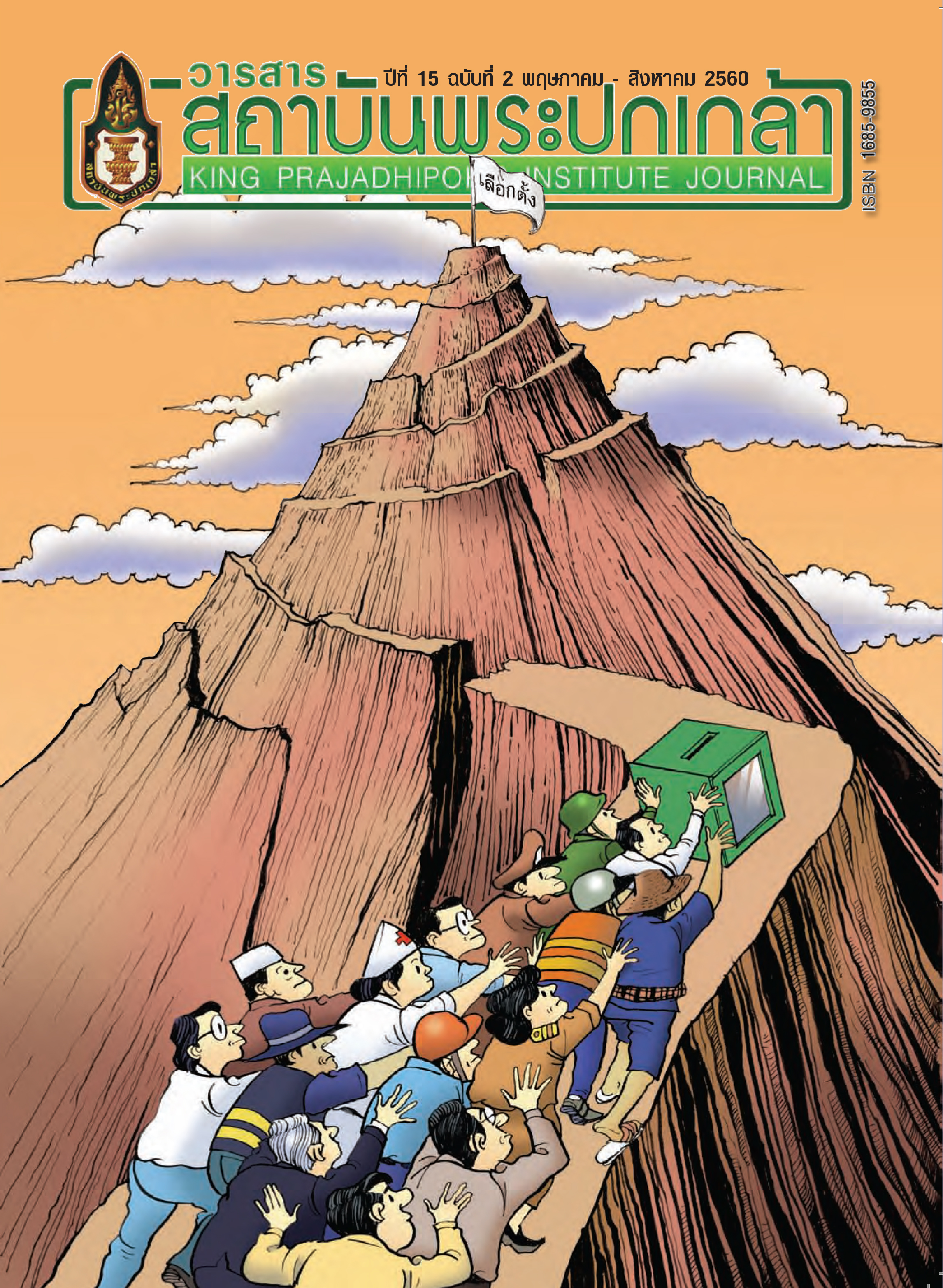Community Capacity Enhancement for the Right for Sustainable Water Management: Communities around Songkla Lake Basin, Thailand
Main Article Content
Abstract
The objectives of the study are to analyze the status and propose an appropriate model for enhancing community capacity to exercise rights to participation in water resource management in Songkla Lake Basin (SLB). Qualitative methods were used in the study by exploring documents, interviews, and group meetings. The results showed that SLB had plentiful and various natural resources. However, SLB faced many problems such as water pollution, flooding, and agricultural water shortages. SLB had existing water resource management facilities, but these were small-scale. A majority of participants felt that their community didn’t have traditions or norms for local water management. A significant minority of 28.4 percent thought their community had very substantial common will for water management. Concern and coordination among the community members was a key success factor to sustain water resource management, and a lack of
budget was the biggest single failure factor. Prioritized issues for enhancing community capacity were leadership, presentation and information, public relations, means of communication with relevant agencies, ownership, writing proposals to obtain water project funds, and planning and managing projects. Four alternative models were proposed to enhance community water resource management capacity: government agency, academic sector, local administrative organization, and civil society organization models. The application of a model depends upon the particular situation, and each model requires different conditions. This study recommends conducting empowerment activities based on community needs. Integration among relevant agencies was also important support to enable community capacity enhancement for planning, implementation, and decision making.
Article Details
@ 2020 King Prajadhipok's Institute The Government Complex Commemorating All Right Reserved.
References
กิตติศักดิ์ ปรกติ. (2550). สิทธิของบุคคลซึ่งรวมกันเป็นชุมชน. กรุงเทพฯ : สำนักงานศาลรัฐธรรมนูญ.
คณิตา ศรีประสม และคณะ. (2549). โครงการสิทธิชุมชนศึกษาภาคใต้ กรณีลุ่มน้ำทะเลสาบ. กรุงเทพฯ : สำนักงานกองทุนสนับสนุนการวิจัย.
วิทยากร เชียงกูล. (2557). เพื่อการปฏิรูปมนุษย์และสังคมอย่างลึกซึ้ง. กรุงเทพฯ : แสงดาว.
ศูนย์วิจัยลุ่มน้ำทะเลสาบสงขลา. (2554). “ข้อมูลเกี่ยวกับลุ่มน้ำทะเลสาบสงขลา”. สืบค้นจาก http://www.songkhlalake.com/content/about
สถาบันบัณฑิตพัฒนบริหารศาสตร์ และกรมทรัพยากรน้ำ. (2554). โครงการวิจัยด้านทรัพยากรน้ำ: การบริหารจัดการทรัพยากรน้ำแบบผสมผสาน (IWRM) ในพื้นที่ลุ่มน้ำทะเลสาบสงขลา. กรุงเทพฯ : ผู้แต่ง.
สำนักงานนโยบายและแผนทรัพยากรธรรมชาติและสิ่งแวดล้อม. (25 มกราคม 2559). “ข้อตกลงอนุสัญญาว่าด้วยความหลากหลายทางชีวภาพ (Convention on Biological Diversity: CBD)”. สืบค้นจาก http://www.onep.go.th/library/index.php?option=com_content&view=article&id=62:-conventionon-biological-diversity-cbd&catid=26:2012-04-02-06-57-22&Itemid=34
เสาวลักษณ์ กุณฑล. (2549). องค์กรจัดการลุ่มน้ำคลองอู่ตะเภาในบริบทการบริหารจัดการลุ่มน้ำทะเลสาบสงขลา. วิทยานิพนธ์คณะการจัดการสิ่งแวดล้อม มหาวิทยาลัยสงขลานครินทร์.
The Aspen Institute Rural Economic Policy Program. (2015). “Measuring Community Capacity Building: Tools for Practice”. Retrieved date July 28, 2015 from http://www.aspeninstitute.org/publications/measuring-community-capacity-
Atkinson, R. & Willis, p. (n.d.). Community Capacity Building – A Practical Guide. Hobart, Australia: School of Sociology, University of Tasmania.
Ivey, J. L. & other. (2004). “Community Capacity for Adaptation to Climate – Induced Water Shortages: Linking Institutional Complexity and Local Actors”. Environmental Management. 33 (1), 36 – 47.
Khalkheili, T. A. & Zamani, G. H. (2009). “Farmer participation in irrigation management: The case of Doroodzan Dam Irrigation Network, Iran”. Agricultural Water Management. 96 (5),
– 865.
Kongthong, O. & Ratanachai, C. (2012). Civil Society in the Songkla Lake Basin. Central Java, Indonesia: Center for River Basin Organizations and Management.
Lackstrom, K. (2011). Institutional Opportunity and Barriers to Climate Adaptation. AWRA 2011 Spring Specially Conference, Baltimore MD.
Measham, T.G. & Lumbasi, J. (2013). “Success factors for Community Based Natural Resource Management (CBNRM): lessons from Kenya and Australia”. Environmental Management. 52 (3), pp 649-659.
Mudrakartham, S. & other. (2010). “Potential and Prospect of Adaptation through IWRM in Rajasthan, India”. Retrieved date August 24, 2016 from http://www.indiawaterportal.org/sites/indiawaterportal.org/files/potential_and_prospect_of_adaptation_through_iwrmclose_0.pdf.
Mumtas, M. & Wichien, C. (2013). “Stakeholder Analysis for Sustainable Land Management of Pak Phanang River Basin, Thailand”. Social and Behavioral Sciences. 91 (2013), 349 – 356.
National Institute of Environmental Health Sciences (NIEHS), U.S. Department of Health and Human Services. (2012). Partnerships for Environmental Public Health (PEPH) Evaluation Metrics Manual. n.p.: NIEHS.
Ostrom, E. (2008). Governing the Commons : The Evolution of Institutions for Collective Action. Cambridge, UK: Cambridge University Press.
Pahl-Wostl, C. & other. (2007). “Social Learning and Water Resources Management”. Ecology and Society. 12 (2), 5.
Razzaq, Abdul Rasid Abdul & other. (2012, July). “Community Capacity Building for Sustainable Tourism Development: Experience from Miso Walai Homestay”. Business and Management Review. 2 (5), 10 – 19.
Saldias C. & other. (2012). “Losing the Watershed Focus: A Look at Complex Community-Managed Irrigation Systems in Bolivia”. Water International. 37 (7), 744-759.
The Scottish Government. (2007). Building Community Capacity: Resources for Community Learning & Development Practice. Edinburgh: Author.
Sokile, C. S. & other. (2002). “Towards An Integrated Water Resource Management In Tanzania: The Role of Appropriate Institutional Framework in Rufiji”. Retrieved date August 24, 2016 from Basinhttps://www.researchgate.net/publication/254791540_Integrated_Water_Resource_Management_in_Tanzania_Interface_between_Formal_and_Informal_Institutions.
State of New South Wales, Australia. (2010). Assessing Natural Resource Manager Capacity: A Best Practice Guide. Sydney South, Australia: Department of Environment, Climate Change and Water NSW.
Stojanovic, T. & Barker, N. (December 2008 ). “Improving governance through local Coastal Partnership in the UK”. Geographical Journal. 174 (4), 344 - 360.
Taylor, M. (2003). Public Policy in the Community. New York, United state: Palgrave McMilan.


